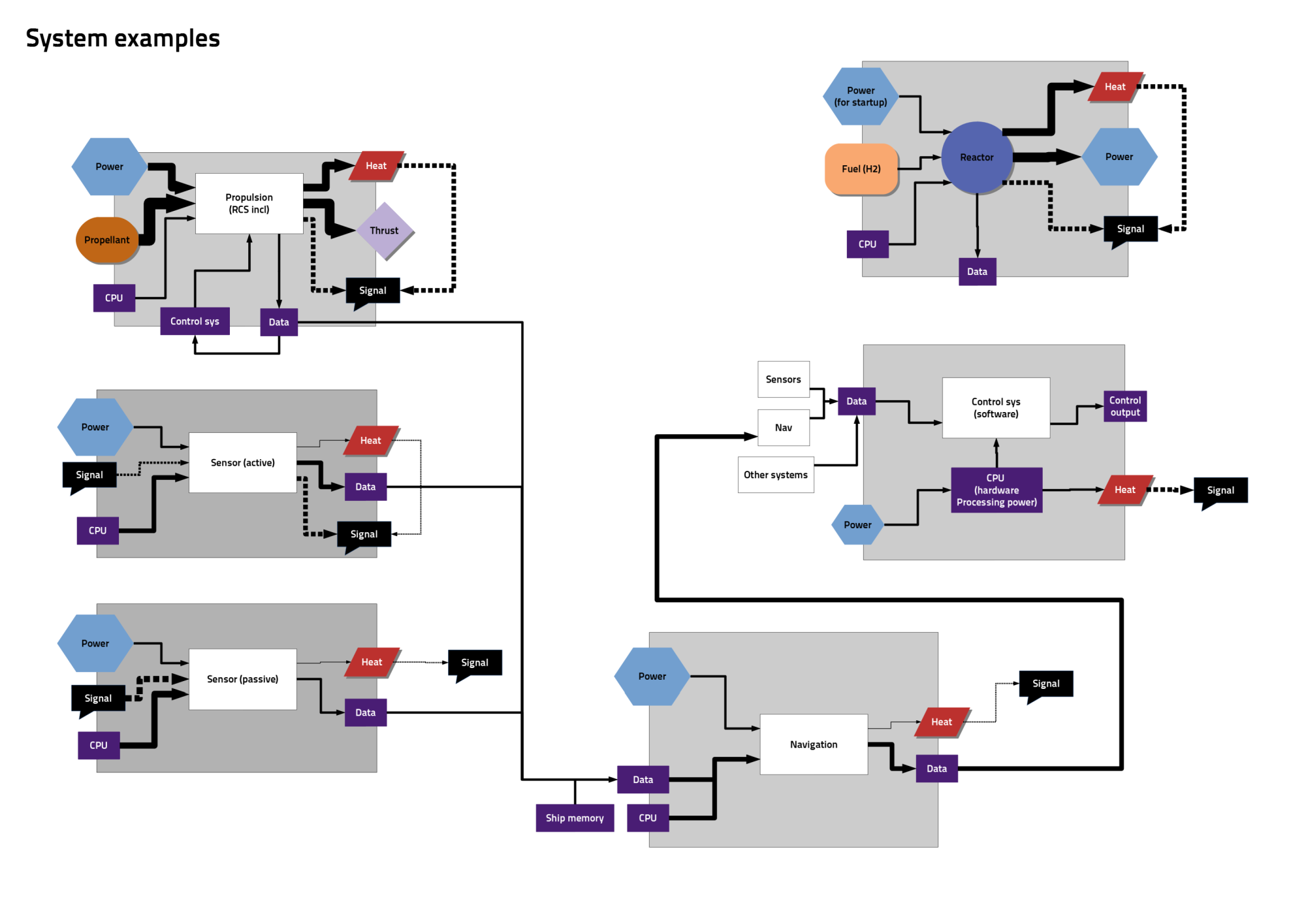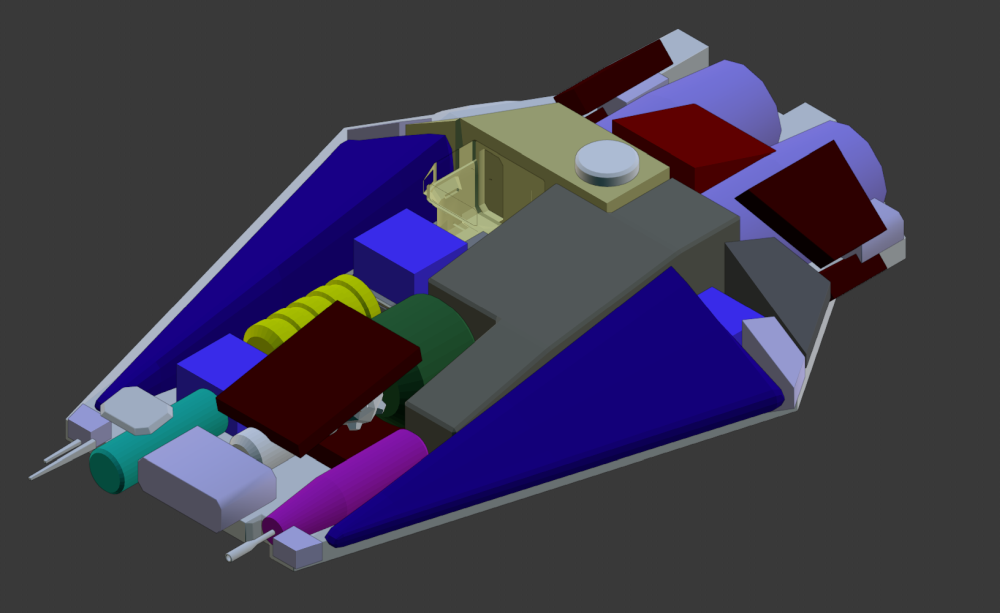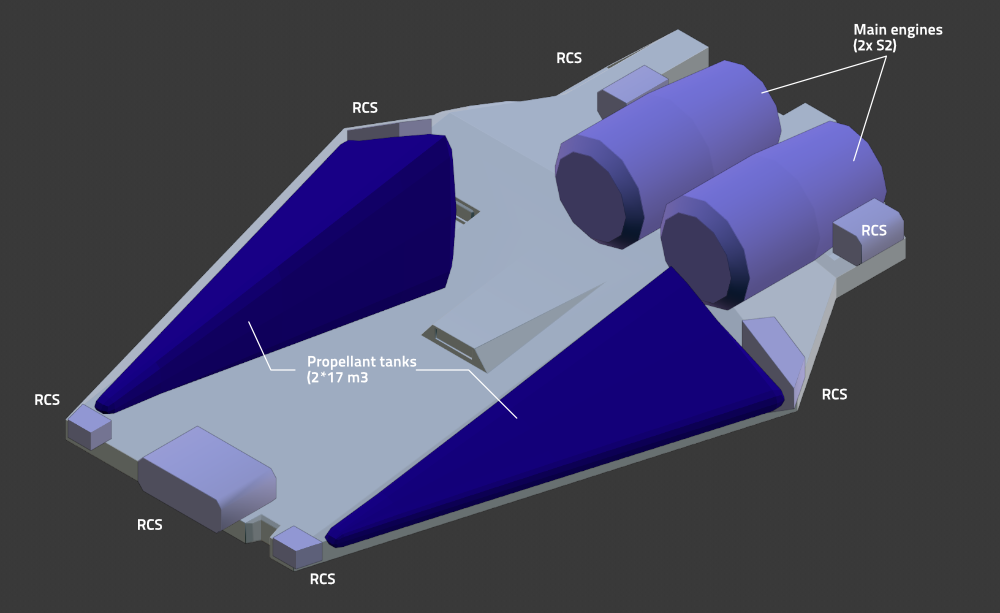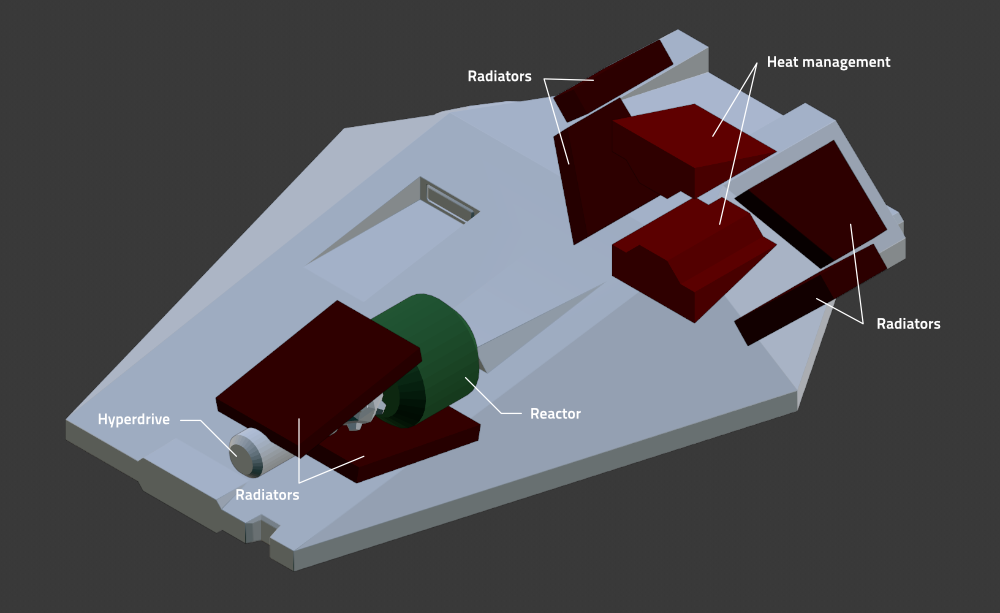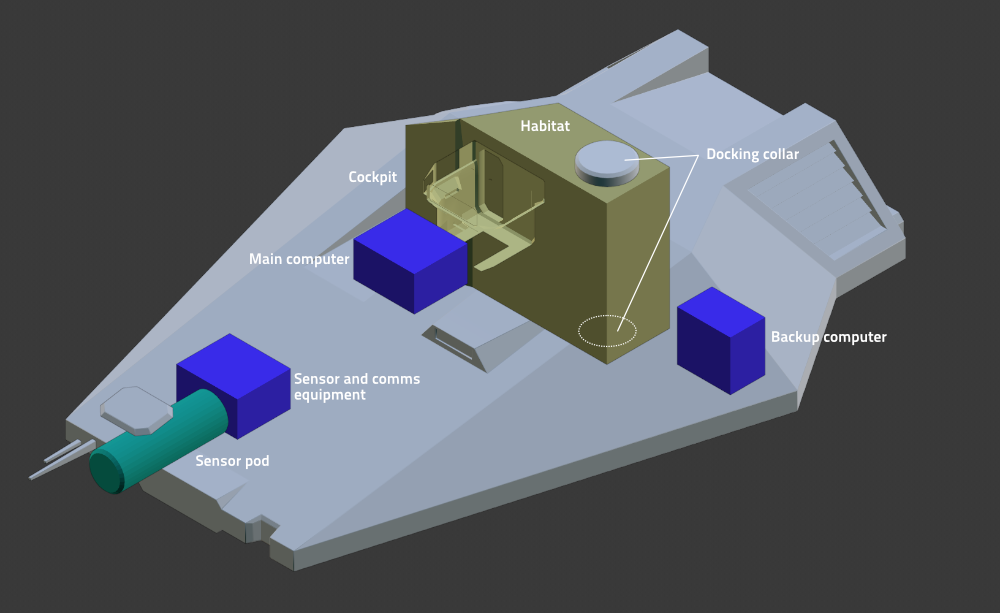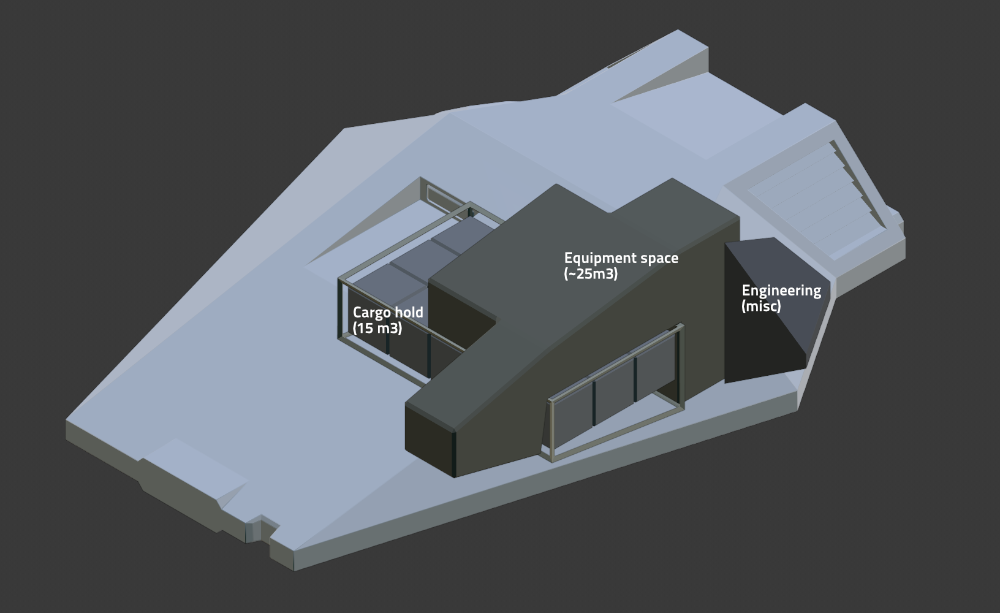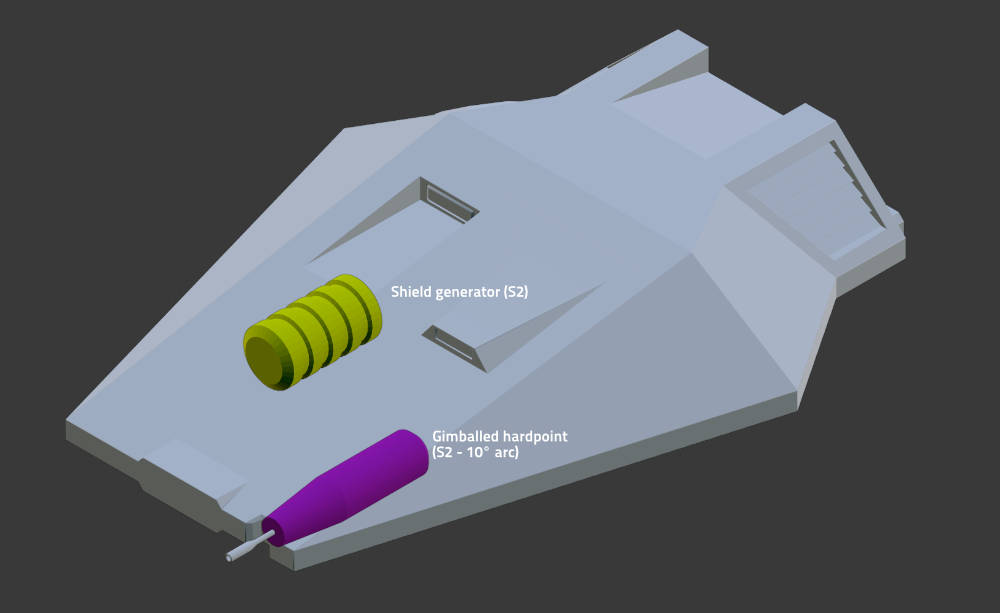Ship struct
Contents
Ship structure
A general idea about how the slots, equipments, and the power/resource system could work. I've started overthinking the topic, in order to start getting on a good base we can edit down to something interesting, believable and fun system. The aim is to provide a detailed system that makes player choices, workarounds, trade-offs possible, and to provide some in-depth ship operation. Not as deep as Rogue System, but somewhat deeper than E:D. (Don't know much about SC)
This document is very much work in progress, but regards to the content and structure. I will update it as we discuss the matter.
Overview
The above image shows the general logic of how the resources are flowing.
Power
- The reactor provides Power (MW), and heat (MJ).
- Other auxiliary systems can generate power as well (possibly even the engines in emergency generator mode).
- The reactor uses fuel (H2 for example, or some kind of specialized reactor fuel pellet). Some aux generators could use fuel too (Fuel cells), some not (Solar panels).
- Power is than taken to the power distributor, which handles the flow of power. Practically summs up the output of all available power from reactors, aux system and such. The overall available power.
- From here power flows to the equipment.
- One special equipment is the power storage (batteries, capacitors) which does not generate, but store power. So power can go from them and to them as well (charging or discarging). These are mostly emergency/backup systems)
- Propellant (water) can be converted to fuel (H2), possibly even back, if the ship stores the oxygen. Good for emergencies, but it incurs losses.
- Aux systems have very meager power output compared to the reactor. Fuel cells have way worse fuel efficiency. This includes the engines when used in power generation mode, which also reduces the exhaust velocity, thus deltaV.
- Equipment can loose functionality if under powered, or shut down altogether.
- Possible there should be a priority list which governs, which system are more important than others.
Heat
- All equipment generates heat, aka efficiency. (MW) (except radiators)
- Heat can come from outside as well, from stars, weapons, atmosphere/reentry etc.
- So each ship has capacity to absorb/endure heat (MJ). If heat isn't radiated, it is stored in the heat capacity. If the ship is over its capacity, then equipment get damaged. The more above capacity, bigger the damage is.
- Each equipment could have heat tolerance, governing, how much damage it gets from heat. Delicate equipment could be damaged even if they are only 20K over their limits, but others could tolerate 1000Ks even.
- Heat is collected by the heat management system.
- Heat management outputs the heat to the heat removal or storage systems.
- Heat removal is done by radiators (-MW)
- Heat storage is done by heat sinks (MJ), which store some materials with large heat capacities, aka coolants. The main point is to provide a temporary buffer when the radiators can't remove more heat.
- Heat is then moved back from the coolant to the radiators, when it can be done. Or the coolant can be jettisoned in an emergency, but then the capacity of the heat sink is reduced, or even gone.
- I can imagine that the coolant reserves could be replenished from propellant stores, meaning you can trade deltaV for heat sink capacity.
- More importantly, the more heat the ship outputs, the more detectable it is, and can be seen from a greater distance. (I'm not suggesting full-on stealth gameplay, but it could be there in a limited manner)
Life support
- Life support is an umbrella term for everything that's needed to make the ship habitable. This includes renewable (heat, air, water, maybe even food) and non-renewable (waste losses) aspects.
- Consumables (/crew/day) are representing the aspects that cannot be renewed. The assumption is that the reclamation systems are quite good, so ships need only small amounts of consumables, but need some nevertheless. (So with 1t a 10 crew ship can fly for months, if the life support system is undamaged).
- Life support is then treated as a resource, a number that indicates, how many person it can support.
- Habitats and life support systems draw power and output heat as well.
CPU
- Another resource indicating, how many equipment the ships computer can operate.
- CPUs also draw power and output heat, and can be damaged.
- Inadequate CPU could reduce equipment efficiency, effectiveness (range for active sensors for example) in general, or render some nonoperational.
Ammo
- There could be ammo stores for weapons. Guns and missile launchers included.
- It could provide trade-off potential: should I amp up the machine gun racks, or bring more missiles?
Signal
- Apart from heat, some equipment could output faint or loud signals which would add to the detectability of the ship.
- Active sensors would make very loud pings for example.
- A poorly maintained or shielded reactor could output a loud electromagnetic signal for example.
Equipment examples
The images above show some equipments resource inputs and outputs.
- Inputs are things that are needed for operation (power)
- Outputs are generated by the system (heat)
Data
Data might be an overthinking, but I think it would be a nice way to estabilish connections between equipment:
- The navigation computer is depending on the ship sensors to pinpoint its location. If sensors are down, you are flying in the dark, or precision can degrade.
- I might gone overboard though. Connection between ship computer and reactor could be an overkill. But in case of larger ships, where equipment are sufficiently separated, it could provide interesting situations. Example the connection between the reactor is severed, so the reactor isn't following power demands, meaning it's output has a ceiling, and if the unused power is turned into heat. Until the damage control crew restores connection.
- Or when the autopilot is separated from the engines, you can't use fly-by wire, only direct aux inputs. So no rotation damping either.
- Or if the propellant tanks aren't connected, the nav computer cannot determine the deltaV reserves, which is another kind of flying in the dark.
- Not sure how it could be done though in a simple enough manner.
Cargo racks
- Each ship would need to install cargo storage areas to actually be able to transport stuff.
- These are means to store and fasten the containers.
- It could be possible to store and transport stuff without them, but with a high risk of damaging the goods and the ship, if the pilot flies even a little bit rough.
- There could be specialized cargo holds for things like liquids, grains, radioactives etc. These things could then be bulk stored, which would mean more capacity compared to storing them in containers, but the trade-off is that they can only be used for that type of cargo.
Passenger cabins
- There could be different tiers and sizes of passenger accommodations. Be it a 5 person luxury suite, a 10 capsule-hotel like 'rooms', 20 bunks, or even just 20 seats in the same space.
- These could even govern, how long a trip could be made. Like there's a comfort rating for all of these, which is then divided by the projected trip length. So even a spoiled brat would put up with a capsule pod if the trip is only a couple of hours, but wouldn't even consider it if the trip would take days. And if you botch it, and the trip takes more time, then the satisfaction of the passenger would go down with every hour of travel, which could mean reduced payouts in the end.
- There could be situations where the passengers don't even care, like when you rescue the a king from a wreck, he would be grateful even if he needs to sit on the floor.
Sensors
- Passive sensors - as it says on the tin. They are just listening, without outputting any kind of signal. They are less effective and precise, but less detectable as well. They draw less power, and output less heat as well. Maybe even easier to maintain. Not sure if they would any cheaper though.
- Active sensors - they emit some kind o signal, 'shine a headlight' to search for things. They can be very loud signal sources, making the ship more detectable, but they are more precise, have better range. Ideally they could be turned off at will.
- Special sensors - made for specific tasks, like planet scanning, industrial inspections, research etc.
Other equipment that need some thought
- Hyperdrives
- Scoops
- Airlocks/docking collars
- Light sources (spotlights)
- Mining equipment (most likely deployable)
- Towing equipment
- Computer softwares (trade analyzer, target analyzer)
- Shields - I think they need lots of thought, to build on the trope in a meaningful way, instead of making it a regenerating second hit point.
- Heat shielding - right now the game doesn't care, how big the ship is, the Atmo shielding is always 1t. From which we can kinda assume that it is some kind of special shield generator that is used to mitigate the reentry heating (there are plasma based things that are theoretized IRL). Alternatively there could be special hull coatings that provide similar functionality (even in an ablative way) There is a nice possibility for trade-offs here as well. You could install a coating, which adds some mass, and there's an upper limit to protection, but is dirt cheap. Or you install a generator, which might mean more mass, and draws power/generates some heat, but provide more protection, but it is more expensive as well.
Slots
This is where I'm at now. I'm thinking about how the equipment size and hookups to ship systems should be treated.
- Should there be fixed size slots (Tiny, Small, Medium, Big, Huge, Are-you-nuts)? Or only volume and mass?
- Fixed slots do make things simpler, but less flexible. Fits better with external equipment as well.
- Volume based approach is more flexible, but most likely mean more headache in the long run.
- There could be a mix between too: Some slots are size based (Weapons, Engines), some are volume based (Which go into an internal volume, like computers, cargo racks).
- I'm not sure if it is a good idea to make sized slots downward compatible. Eg. you can fit a small weapon to a large slot.
- On one hand it allows for more flexibility
- On the other hand it will look very ugly if you put a peashooter on an artillery mount.
- I think I'd go with a one-down approach: you could put a one size smaller equipment on that slot, but nothing smaller. (or larger, obviously)
- There could also be a power/heat capacity for each slot. So even if the slot is good for an equipment size-wise, but on that ship it might not be able to provide the needed power.
- Another thing to consider is that universe-wide compatibility seems to be a stretch, even in the 3200's. Manufacturers can be an ass, and try to limit your options to their upgrades for example, while others don't care much.
- This is another good way to introduce decisions - trade-offs.
- There could also be ways to attach non-fitting equipment, but that costs money, and could introduce drawbacks (less sturdy, harder limit on power, etc)
- Would mean more work when balancing, but I think it would worth it, because of the player choices / obstacles to overcome it would introduce
Stealth
This is sure a controversial point, because stealth doesn't really exist in space.
But I think it could still be incorporated in a limited manner. Most articles I read kinda assume military grade detection equipment, and large arrays of them even. But since Pioneer mostly on the civilian side of things (even if there's combat), I think we can assume that the commercially available sensors aren't that effective, especially since you only have one of them, not an entire array on high orbit.
Some scenarios (which could work both ways)
- In high security systems, there is a strong infrastructure in this regard. Transponders are mandatory, and anyone flying without it would be flagged on the system-wide scan that's available to all ships.
- But even then a pirate could still jump on you from the cover of an asteroid for example. Sure they'd be detected as soon as they launch, but they'd have enough time sacking you and jump out before law enforcement could arrive.
- In outback systems, there's no system-scan available, so an off-transponder ship might get close enough to you, drifting cold. You can detect them as soon as they get close enough, or start firing their engines, but by that time you might not be able to get away.
- In the same outback, you might choose to drift cold for as long as possible, in hope to avoid any detection from wolfpacks patrolling around. Hoping that they won't be close enough to intercept you before you start decelerating to your target.
Anyhow, I'd say, these tactics should be more for the last resort, not for the routine, because of their very high unpredictability.
Another interesting aspect
Each ship could have a certain signature, depending on the ship type and equipment installed. This would make identification quite easy even with the transponder off or faked (which both are felonies by the way). So if you know that somebody is looking for you, you could switch out some equipment, and hope to be less noticeable in a high traffic system for long enough to get away or finish a job.
Shields
I think shields in general should not just be treated as a secondary layer of regenerating health bar. For example:
- It is a somewhat form fitting chubby bubble around the ship at a small distance.
- Because of this, a shielded ship provides a bit larger target.
- This can even be a drawback, because even if the hit that would otherwise miss the ship itself connects with the shield, it does deliver some damage, and heat.
- It does not protect from 100% of any damage.
- It absorbs a percentage of incoming damage, but never 100%
- Better, more expensive shields could provide better protection
- The equipment heats up on each hit, as it absorbs damage.
- More heat means more heat for the radiators to get rid of
- The more hot it is, the less effective it becomes in protecting the ship. Absorption percentage drops
- If it overheats, it is destroyed, and can even damage the ship when that happens.
- To avoid this, the ship computer shuts it down and let it cool when it hits a certain threshold.
- The player can tinker with this setting and risks its consequences.
- Shields provide different amount of protection against different kind of attacks.
- It works best against kinetics, like slugs and missiles.
- The faster the projectile goes, the better it protects against it. So if you shoot slow enough projectiles, those can get past it, but won't deal that much damage because their low speed.
- This opens up the door to missiles that try to fly inside the ship slowly, then release a fast projectile or laser/plasma bolt when close enough.
- It works best against particle/plasma beams (which would do lots of damage on the hull)
- It is almost useless against lasers (but to balance that, I'd say the laser should need to be aimed at the same spot for a bit of time to be able to heat up the hull enough to cause damage.)
- A large volume alpha strike to overload it could be a feasible tactic.
Ship Sizes
I'm thinking about formalizing the sip size classification a bit more, to make it easier to think up ships.
- S0 - A bulkier EVA suit or Space Taxi or Space pod
- S1 - Tiny: About the size of a van at most. Intended for very short ranges, apart from some extreme examples.
- S2 - Small: Sinonatrix is a good example. Intended for one person somewhat comfortably. A cockpit and capsule cabin, maybe a small head and galley area. One could live in such a ship, but it won't provide much comfort. Has about 30 m3 hold. For the military, these would only be low endurance, like couriers, strike crafts, interceptors, etc.
- S3 - Medium: Natrix, Mola Mola. Can house a crew of a couple or so, maybe even comfortably. One could live in a ship like this without much hassle. Has about 80-200 m3 cargo hold. These would still be relatively low endurance military crafts.
- S4 - Big: Mola Ramsayi, Deneb or Malabar. Large crafts, up to about 800m3 holds. Can house a decent crew and can provide very good endurance as well.
- S5 - Large: DSMiner maybe, but at the lower end. Very large crafts with holds above 1500 m3. These are the largest crafts most ports can berth. Some might be able to land on high-gravity worlds, but most can't. Even less of them can enter into thick atmospheres.
- S6 - Bulk: Very large ships, with above 3000 m3 cargo holds. They land very rarely on high-gravity worlds (with the exception of colony ships, but those never launch again in most cases, but act as the hearth of a new settlement). Most of them can bring along smaller crafts, up to S3 usually, for cargo unloading and planetfall.
Ship Roles
These are the second way to differentiate ships.
- Shuttles: Short range crafts, usually cheap. Their engines are typically strong but not too efficient, and they have low delatVs (1-3000 km/s max). They are about the cheapest category. Emphasis is on simplicity and cheapness.
- Passenger shuttle: Little cargo hold, huge amount of seating, or cabins for passengers. Like a local bus or airliner or ferry.
- Cargo shuttle: Huge cargo hold, small tanks, little room for passangers. A truck.
- Couriers: Very long range, fast crafts, intended to transport messages and small packages. They are usually really small and tightly packed, but provide some versatility in equipment space. Very small hold and habitat, large tanks, very efficient and strong engines. Sometimes a weapon or two, but the typical doctrine is avoidance. Emphasis is on deltaV and thrust, against everything else. They are very expensive.
- Transports: Purpose-built for transportation of things or beings. They can provide the capacity for it, but they typically lack the equipment mounts, thus versatility. But because of they, they are cheaper. Usually efficiency is more important than performance, so emphasis is on deltaV rather than thrust.
- Passenger ships: Longer range passenger transport ships. Relatively small cargo hold, a large habitat. Performance and efficiency and endurance can vary, but still quite better than a shuttle.
- Freighters: Longer range cargo ships. Large hold, small habitat. Performance isn't that good usually, but they are quite efficient usually, at least compared to a transport.
- Multirole: Crafts made for versatility. They can do a lot of things, but won't excel in any. On the other hand, they can be refit to different tasks as the need arises. They do this by providing ample room and mounts for equipment, and the ease to move and remove them. A much liked ship class among adventure inclined people, explorers, bounty hunters, treasure hunters, safari organizers, criminals and crooks alike.
- Combat: ships intended specifically for combat.
- Fighters: Ships inclined for direct confrontation, for the offensive. Usually they have medium endurance.
- Interceptors: Similar to shuttles. Low range, high performance combat crafts. Usually has very small cargo hold, if any. They might be expensive for a civilian, but still cheap compared to other combat crafts.
- Patrol crafts: Combat crafts geared towards long endurance.
- Dropship: Shuttle equivalent. Usually has large access hatches for fast disembark. Might sport some weapon mounts.
- Transport: equivalent of the non-combat category, but intended for combat scenarios. Troop transports, hardware transports.
- Military: Similar to, but not limited to the Combat category. A broad one at that, since any space force has their own specifications, doctrines and roles.
Sinonatrix example
I used the Sinonatrix as a testbed to check out how the equipments could look inside the ship.
These are all internal equipment, only the comms antennas, the sensor pod and the barrel of the weapon are visible from the outside. Apart from the main engines and RCS nozzles of course.
The Sinonatrix is a quite tightly packed ship that still sports a somewhat ample room for additional internal equipment.
Propulsion
There are two Size 2 main engines and several RCS clusters around the ship. It doesn't have any dedicated retro thrusters, which means its maneuverability isn't that good.
I'd think these are Size one RCS pods.
I could imagine a couple of retro thrusters attached externally on the front side part.
Power
There are several radiators clustered around the three most high-heat parts: the main engines, the reactor and the hyperdrive.
There is an additional Heat management system at the back of the ship, mostly a small heatsink
The hyperdrive is directly attached to the reactor (this could be the standard way). One point: the front landing gear could interfere with the hyperdrive with this setup, that might need some rework. I think I'd add two nose gears towards the side a bit.
I didn't include any power storage, those could go into the equipment space.
Habitat, control, sensors, comms
There is about 25m3 of habitat space, which is about the minimum for one person on a long voyage. This includes sleeping quarters, living space, galley, head, etc. Also both the top and down airlocks and the side hatch is included in this volume. Life support systems are also included in it. Anyhow, this ship is quite uncomfortable without modifications.
The docking collars are Size 2
There is a main computer and a backup.
The sensor pod is for the high powered, narrow cone sensors. Additionally, the ship should have several smaller clusters of sensors for maximum coverage. The main sensor is for when you need to look actively for something. There could be an additional rear one, because you'd kinda need it during deceleration.
Comms could work in a similar way. One or two main long range antenna, and a bunch of weaker unidirectional embedded into the hull.
Cargo and equipment space
There is a dedicated 15m3 cargo rack on the belly of the ship. This provides proper attachment for the cargo containers, and has a belly hatch for loading and unloading. Possibly even a very simple crane.
There is a small engineering section to the righ, housing additional ship systems (power management, propellant gauge, misc stuff)
There is a quite irregularly shaped Equipment space as well. This could be further sectioned up for fixed internal equipment, like heat management and such. Maybe even the life support systems could go in here.
Provides crawl space as well, for maintenance and repairs.
In general this space is for any equipment that doesn't need a specialized mount. You just swap it in, bolt down, and you are good to go.
Some, if not all of it could also be converted into cargo space.
Combat equipment
The Sinonatrix isn't really designed for combat, so it has very little to show in this regard.
There is a Size 1 Shield generator. I think shields should work like this: there is the generator equipment, which needs to be hooked up to an array of emitters around the hull. When you replace your shields, it is assumed that the emitters are replaced too, this is mostly the fiction side. The point is, that it isn't just something sitting in the ship emitting, but is tied to the structure. Hull damage could even reduce shield effectiveness because of this.
There is only one Size 2 internal weapon mount on the Sinonatrix. It can mount a fixed or gimballed weapon. If gimballed, it rotate 5° in each direction. I could imagine that it could be replaced with a missile tube and feeding mechanism, since the equipment space is right behind it.
I could also imagine that the top and bottom docking collars could be used as weapons hardpoints if the need arises. Not as good choice as a dedicated hardpoint though.


